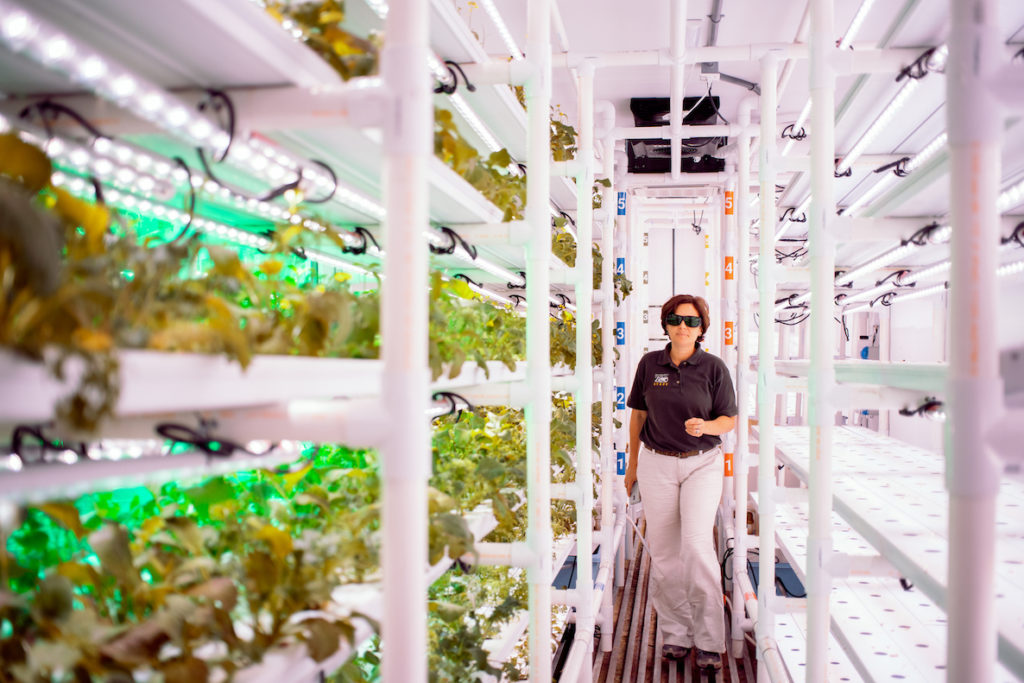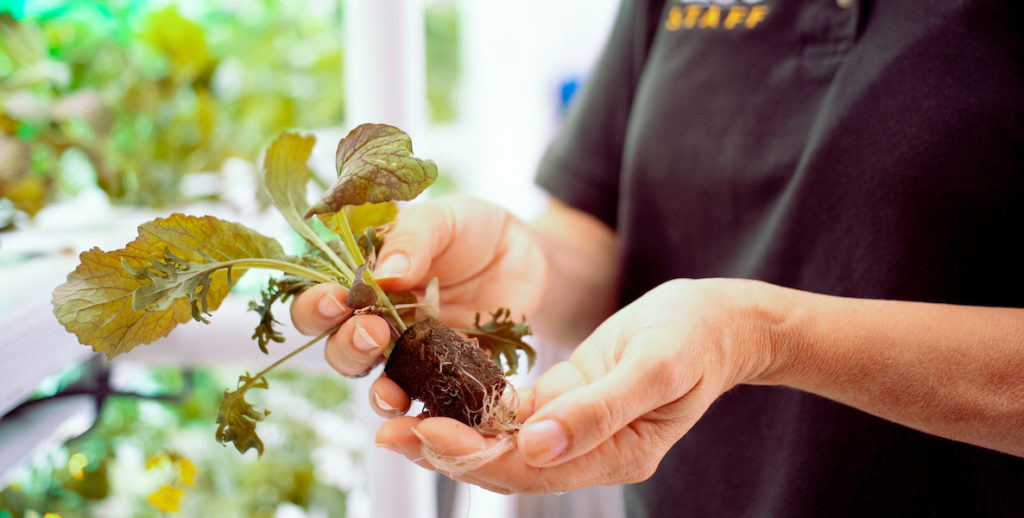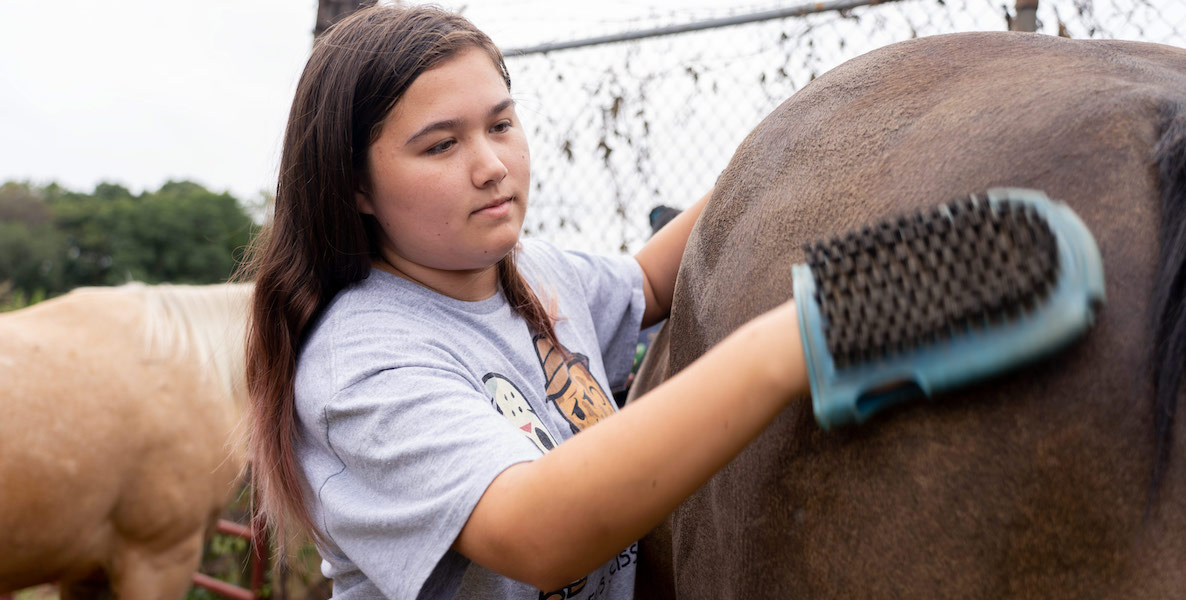If you’re a fan of homegrown arugula and mustard greens, you may just have the same taste as Tua, a 27-year-old Sumatran orangutan.
That’s according to The Philadelphia Zoo, which over the last five months has become the first zoo in the country with its own vertical garden growing leafy greens on-site to feed its animals. The program, still in its pilot stage, aims to reduce the zoo’s carbon footprint, all while meeting the nutritional needs of its animals and supporting food security in surrounding neighborhoods.
In a shipping container at the zoo, stacked shelves hold rows of plants that are grown hydroponically, in nutrient-rich water instead of soil. LED lights, as a substitute for sunlight, shine for 18 hours a day. Farm operators remotely control the level of light, temperature and humidity in the space using a mobile app.
You can find the vertical farm in The Urban Green, the zoo’s open-air food marketplace. A mural, by Philly-based environmental artist and activist Eurhi Jones, transforms the front of the shipping container into a colorful collage of the animals who chow down on the food grown inside.

Kristen Lewis-Waldron, director of strategic initiatives at the zoo, says the vertical farm is far more sustainable than bringing in food from outside sources. It uses 70 to 90 percent less water than traditional farming, has no need for pesticides or herbicides and cuts greenhouse gas emissions out of the equation, since no transportation is necessary.
“It really kind of creates this farm-to-table [model]—in this case, shipping container-to-exhibit,” Lewis-Waldron says.
Lewis-Waldron, who heads the project, is short on farming experience, but knows a thing or two about feeding animals. She landed her first role at the zoo 23 years ago—as a nutrition intern. She went on to work for, and eventually lead, the zoo’s conservation department, before transitioning to her current position. But growing greens for the animals makes her feel like she’s come full circle, she says.
To pull the project off, Lewis-Waldron enlisted the services of the CropBox—which is also what the zoo calls the vertical farm. The North Carolina company provides the equipment—including the shipping container—to interested partners and helps to set up the system.
Lewis-Waldron also consulted with industry experts, including people that operate their own vertical farms, in order to ask for best practices and advice in troubleshooting technical challenges. All in all, the preparation process took about a year.
Some of the changes are visible to visitors, like Zoo360, a system of trails overhead and below ground that have provided more space for the animals on the 42-acre urban location—an example for zoos around the country that is also good for animal mental health.
Some are less so: capital fundraising and audience growth that have made the zoo economically stable for the first time in its history; activism and education about global environmental and animal health; programs to reach out to the local community.
In its five months of operation, the CropBox has fed 20 animal species with its microgreens. It produces 275 pounds of leafy greens a month, which is only 10 percent of the zoo’s monthly requirement for leafy greens. But that number, Lewis-Waldron says, will grow once the pilot year is complete and the project is expanded.
“Just like you have to think about what’s so important about what you eat, how that makes you healthy inside and out,” Lewis-Waldron says. “It’s the same kind of thing that we’re thinking about every day for these animals, many of which are critically endangered.”
“You can take over a vacant warehouse or vacant building and convert it,” she says. “You could take six of these and make a dent in the requirements of our collection.”
The CropBox also benefits the zoo economically by replacing a collection of food that it would otherwise purchase.
But perhaps most importantly, the greens grown in the vertical farm are rich in nutrients. The Philadelphia Zoo takes animals’ diets very seriously, and even employs a full-time nutritionist. By feeding leafy greens to the animals, the zoo is keeping their health in tip-top shape.
Greens may be good for the animals, but that doesn’t mean they’re every species’ favorite snack. Just like humans, animals have unique palates. And the current variety growing in the CropBox—a stir-fry mix that includes arugula and mustard greens—isn’t always a crowd pleaser.
“It’s got a little kick to it, a little bit of spice. Our emus were a little hesitant,” Lewis-Waldron says. “But our monkeys, langors, apes, gorillas, orangutans, tortoises absolutely love it. So it’s interesting, and we’ll continue to test out different types of greens.”
Lewis-Waldron says that the program doesn’t just benefit animals and the environment. Once it gets off the ground, it can also serve people in the neighborhoods surrounding the zoo, many of whom suffer from high poverty rates. Nearby Mantua, for example, has a 46 percent poverty rate, according to Census data released last year.
In fact, the vertical farming idea was born during the zoo’s community outreach efforts.
“We spent the last couple years really thinking about our role and our community engagement strategy, and really deepening that,” she says . “We spent several months talking to our neighborhoods, doing community stakeholder sessions. Urban gardening was the number one thing that came up in those conversations.”
The zoo has begun quiet talks with community organizations to set up what Lewis-Waldron calls a “social impact business enterprise.” Under the tentative plan, a neighborhood partner would learn urban agriculture skills from the zoo and use them to run its own vertical farming business. The zoo would be a guaranteed buyer, and nearby residents would gain access to fresh produce—all while supporting a green local economy.
“We know that based on where the zoo is located, in an urban setting, this is the future of food right here,” Lewis-Waldron says. “It’s important when you’re in an area that has more food deserts. Here’s a unique opportunity to have healthy, nutritious food delivered to your door in a very sustainable, efficient way.”
Chris Spahr, executive director of the Centennial Parkside CDC, a nonprofit that promotes the development of the East Parkside neighborhood near the zoo, says the community is already home to several urban gardens attempting to fill the gap in food access.
Support and additional resources from the zoo would boost those efforts, and potentially open the door to partnerships that Spahr says are long overdue, from other nearby institutions like Drexel University, the University of Pennsylvania and the Please Touch Museum.
“Maybe it’ll be a motivator for these larger institutions to step up and use their power in the community to advance some of these local purchasing and employment models,” he says. “Not to say they are not doing it at all. I think there can always be more done to narrow this equity gap and lower the poverty rate, while still protecting our environment and combating climate change.”
Already, the CropBox is providing numerous educational opportunities. Zoo employees hold a talk at 1pm every day at the farm, to explain how it works and offer visitors a glimpse into the window. The zoo has also piloted activities in which children can interact with the farm, from watering the native plants around the CropBox to feeding microgreens to the animals.
“We know that based on where the zoo is located, in an urban setting, this is the future of food right here,” Lewis-Waldron says. “Here’s a unique opportunity to have healthy, nutritious food delivered to your door in a very sustainable, efficient way.”
Lewis-Waldron adds that the zoo’s community engagement has included preliminary discussions with an undisclosed nearby school to incorporate hands-on vertical farming lessons into the curriculum.
The vertical farm is just one of several ways the zoo is making its operations more sustainable. According to its 2017 sustainability report, the zoo has improved the energy efficiency of its buildings by 30 percent and reduced its energy use by 17 percent since 2011, thanks to a handful of initiatives. For example, the zoo converted its golf car fleet—which employees use to get around campus—to solar-powered vehicles. It also built geothermal wells to generate clean power.
It’s all part of the zoo’s mission to be a role model, for both its guests and for other zoos around the world, in the hopes that its sustainability efforts will be replicated and spread.
“How can we get our guests and our audiences actively involved in conservation, and inspire them towards action?,” Lewis-Waldron asks. “How can we leverage our 42 acres and show people, these are the simple and easy ways that you can get involved?”
Related


